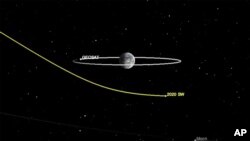Scientists at the U.S. space agency NASA say a small asteroid – roughly the size of a bus – passed close to Earth on Thursday, flying just 22,000 kilometers above the surface, within the orbit of geostationary satellites that ring the planet.
While the proximity to Earth might raise alarm, scientists at NASA's Jet Propulsion Laboratory (JPL) in Southern California said even if the asteroid had entered the earth’s atmosphere, it almost certainly would have broken up and become a bright meteor.
The asteroid, known as 2020 SW, is about five to ten meters wide and was first discovered on September 18 by the NASA-funded Catalina Sky Survey in Arizona.
NASA’s Center for Near-Earth Object Studies (CNEOS) -- part of the JPL -- then did follow-up observations and confirmed its orbital trajectory, ruling out any chance of impact.
CNEOS director Paul Chodas says an object this size, this close to earth, is not uncommon. He says, "In fact, asteroids of this size impact our atmosphere at an average rate of about once every year or two."
After passing the Earth, the asteroid will continue its journey around the Sun, not returning to Earth's vicinity until 2041, when NASA says it will make a much more distant flyby.
The space agency says they believe there are over 100 million small asteroids like 2020 SW, but they are hard to discover unless they get very close to Earth.
In 2005, Congress assigned NASA the goal of finding 90 percent of the near-Earth asteroids that are about 140 meters or larger in size. These larger asteroids pose a much greater threat if they were to impact, and they can be detected much farther away from Earth, because they're simply much brighter than the small ones.
Chodas says NASA's asteroid surveys are getting better all the time, and the agency now expects to find asteroids the size of 2020 SW a few days before they come near Earth.









